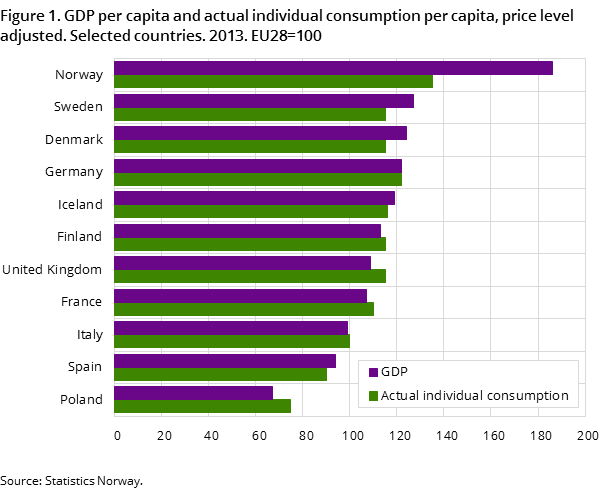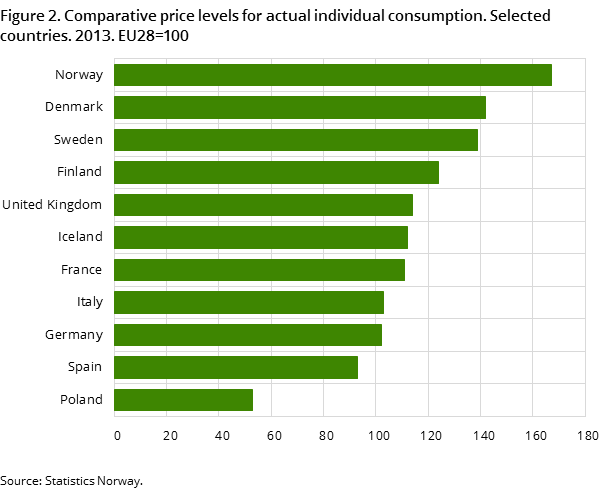Content
Published:
This is an archived release.
Luxembourg, Norway and Switzerland on top
Figures recently released by Eurostat show that Luxembourg, Norway and Switzerland had the highest price level-adjusted Gross Domestic Product (GDP) per capita in Europe in 2013. In the survey, Norway is the most expensive country in Europe. There was a noticeable positive development in the Baltic states in the survey period.
| 2013 | |||
|---|---|---|---|
| Gross Domestic Product | Actual individual consumption | Actual individual consumption | |
| Volume indices of real expenditure per capita (EU28=100) | Volume indices of real expenditure per capita (EU28=100) | Price level indices (EU28=100) | |
| 1Source: Eurostat | |||
| Norway | 186 | 135 | 167 |
| Iceland | 119 | 116 | 112 |
| Sweden | 127 | 115 | 139 |
| Denmark | 124 | 115 | 142 |
| Finland | 113 | 115 | 124 |
| France | 107 | 110 | 111 |
| Italy | 99 | 100 | 103 |
| Poland | 67 | 75 | 53 |
| Spain | 94 | 90 | 93 |
| United Kingdom | 109 | 115 | 114 |
| Germany | 122 | 122 | 102 |


In 2013, Norway’s price level-adjusted GDP per capita was 86 per cent above the average of the 28 EU countries (EU28). Only Luxembourg had a higher GDP per capita than Norway. The extraordinary result for Luxembourg is due to the fact that a large share of the country’s employees live in the neighbouring countries and thus contribute to GDP without being included in the population. Next on the list after Luxembourg and Norway is Switzerland, with a GDP per capita of 63 per cent above the average of the EU28. The Netherlands, Ireland, Austria, Sweden, Denmark and Germany followed, with a GDP per capita of 22 to 31 per cent above the EU28. The countries in Eastern and Central Europe in general had a lower GDP per capita compared to the Western European countries.
2011-2013: positive development in the Baltic States
For most of the countries, there were minor changes in the GDP per capita from 2011 to 2013. There was a noticeable positive development for some countries in Eastern Europe from 2011 to 2013. The Baltic States of Estonia, Latvia and Lithuania led the development. Estonia and Lithuania’s GDP per capita is now at the same level as Greece, while Latvia’s is slightly below this. Macedonia and Romania also had a positive development. The greatest negative changes were found in Cyprus, Greece and Italy. Among the larger EU countries, the picture is stable during the period for Germany, France and Spain, while the United Kingdom and Poland showed a positive development.
Consumption levels highest in Norway
Luxembourg and Norway also lead the comparison for actual individual consumption per capita, with 36 and 35 per cent above the average of the EU28 respectively. Actual individual consumption in Norway is almost 20 per cent higher than the other Nordic countries. Germany and Austria also have high levels of actual individual consumption, at 22 and 20 per cent higher than the average respectively.
Figure 1 shows the level of both GDP and actual individual consumption per capita. It is noticeable that there is a large difference between the level of GDP per capita and actual individual consumption per capita for Norway compared to other countries. This can be attributed to parts of the country’s income being spent on collective consumption, gross fixed capital formation or foreign assets.
Norway is Europe’s most expensive country
Figure 2 shows the price levels in selected European countries relative to the European average. The figure shows the price levels for goods and services for actual individual consumption. Norway is Europe’s most expensive country in 2013, with a price level that is 67 per cent above the average. Switzerland is almost as expensive as Norway. If we compare Norway’s price level with its neighbours, it is 17 per cent above the level of Denmark and 20 per cent above the level of Sweden. Other countries with relatively high price levels are Luxembourg, Finland and Ireland. The countries with the lowest relative price levels in the survey are situated in South Eastern Europe. In Macedonia, Bulgaria and Albania, the price levels of goods and services for actual individual consumption are around a quarter of the level in Norway.
From EU27 to EU28; Croatia became a member state on 1 July 2013Open and readClose
The level of GDP and actual individual consumption per country is expressed as indices relative to the average of the 28 EU member states (EU28=100), after Croatia became an EU member state on 1 July 2013.
GDP and actual individual consumption per capitaOpen and readClose
While gross domestic product (GDP) per capita is often used as an estimate of the material prosperity of a country, “actual individual consumption per capita” may provide a more accurate picture of residents’ actual living standards. Actual individual consumption measures the amount of goods and services consumed by individuals, independent of whether these are paid for by private households or the public sector.
This page has been discontinued, see Comparison of price levels in Europe, Annually.
Additional information
Contact
-
Birte Larsen Sandstå
E-mail: birte.sandsta@ssb.no
tel.: (+47) 92 60 56 03
-
Hamdi A. Mohamed
E-mail: hamdi.mohamed@ssb.no
tel.: (+47) 46 81 54 76
-
Norway-ppp@ssb.no
E-mail: norway-ppp@ssb.no
